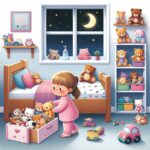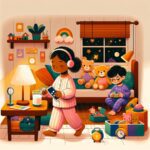Creating a bedtime routine for twins with different sleep needs is a journey of patience, understanding, and flexibility. Every parent dreams of a peaceful nighttime routine, but when twins have varying sleep necessities, the challenge doubles. In this guide, we’ll explore strategies, tips, and insights to help you craft a bedtime ritual that accommodates the distinct requirements of your twins, ensuring they both drift off to dreamland content and on schedule.
Understanding the Importance of Individualized Bedtime Routines
Twins, despite sharing a birthday, can have vastly different personalities, preferences, and yes, sleep needs. One may struggle to fall asleep without a specific lullaby, while the other might require complete silence. Acknowledging and respecting these differences from the outset is crucial. Start by observing and noting their individual sleep cues and patterns. This understanding serves as the foundation for creating a bedtime routine for twins with different sleep needs, ensuring each child’s unique necessities are met.
Research supports the significance of tailored bedtime routines in promoting healthy sleep habits. A study published in the journal Sleep Medicine Reviews highlights the positive impact of consistent bedtime routines on children’s sleep quality and duration. Thus, establishing a routine catering to each twin’s needs not only encourages better sleep but also fosters a sense of security and predictability.
Creating a Bedtime Routine for Twins with Different Sleep Needs
Embarking on creating a bedtime routine for twins with different sleep needs requires flexibility and creativity. Begin by setting a consistent bedtime, which serves as a signal to their bodies that it’s time to wind down. However, the activities leading up to sleep might differ. For instance, one twin might benefit from a warm bath to relax, while the other prefers quiet time with a book. It’s essential to individualize these pre-sleep rituals to match each twin’s comfort and sleep triggers.
Simultaneously, creating a conducive sleep environment is critical. This includes everything from the right room temperature—which experts suggest should be between 68-72°F for optimal sleep (ideal room temperature for baby sleep in winter)—to minimizing noise and light pollution. For twins sharing a room, consider using white noise machines or lullabies to mask disruptive sounds. The debate between white noise machines vs lullabies for infant sleep indicates that both can be effective, so you might need to experiment to see what works best for each child.
Addressing Common Challenges in Twin Sleep Routines
One of the most significant challenges in creating a bedtime routine for twins with different sleep needs is managing disruptions. When one twin wakes up, it often disturbs the other. To mitigate this, consider separate sleeping arrangements if space allows. If they share a room, strategic placement of cribs and the use of soundproofing materials can help minimize disturbances.
Another common hurdle is the varying degree of dependency on nighttime feedings or comfort items. Gradually weaning each twin off these dependencies according to their readiness can help. For insights on handling night feedings with minimal sleep disruption, visit this resource. Moreover, consistency is key. Even when facing setbacks, maintaining the routine as much as possible will eventually lead to success.
In conclusion, crafting a bedtime routine for twins with different sleep needs is a delicate balance of understanding, patience, and consistent effort. By respecting each twin’s unique requirements and being flexible in your approach, you can create a peaceful bedtime routine that ensures restful nights for your twins and the entire family. Remember, it’s not about perfection but progress. With time and patience, you and your twins will find a rhythm that works for everyone.
For further reading on twin sleep solutions and other parenting tips, explore our extensive Sleep Training Twins: Methods and Considerations guide and other resources available on our site.













